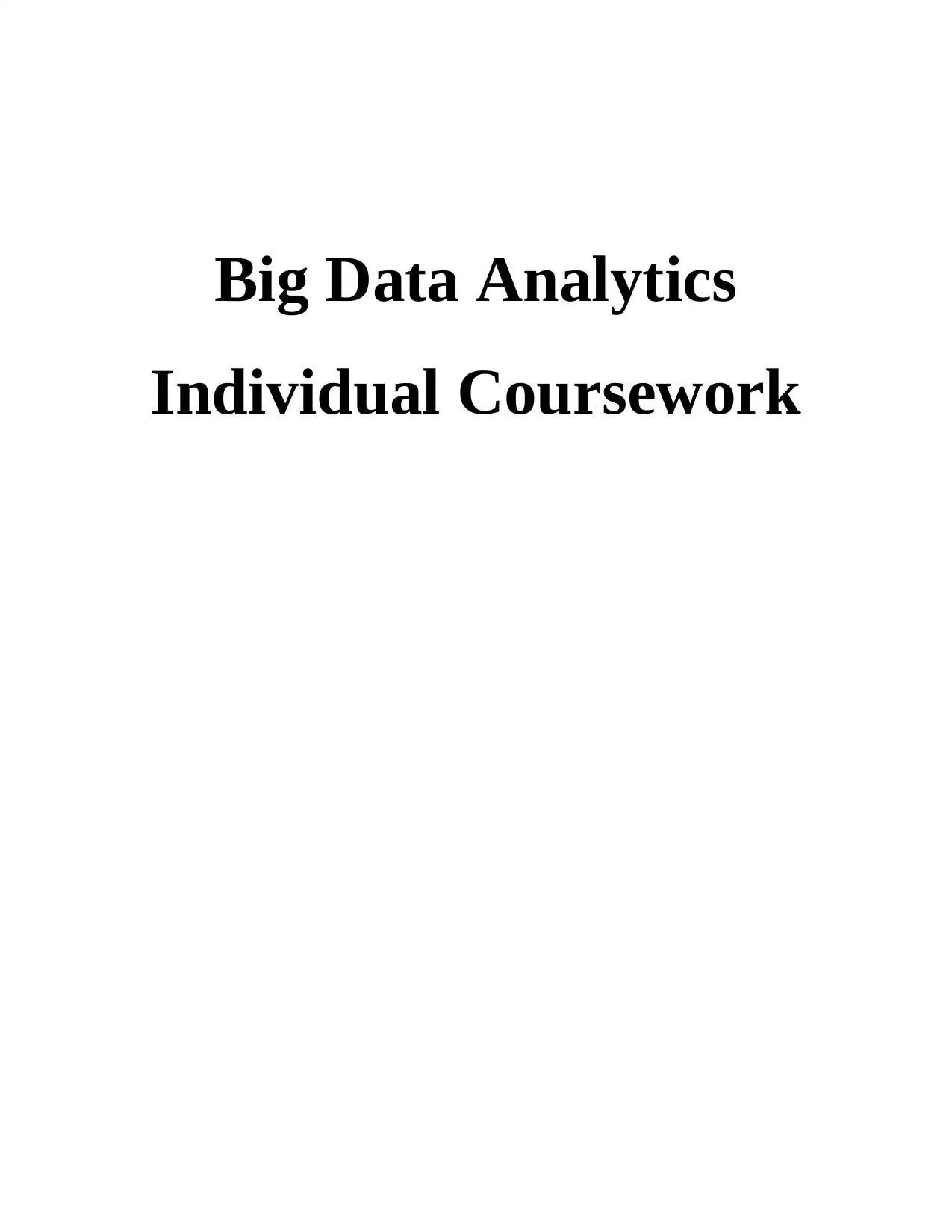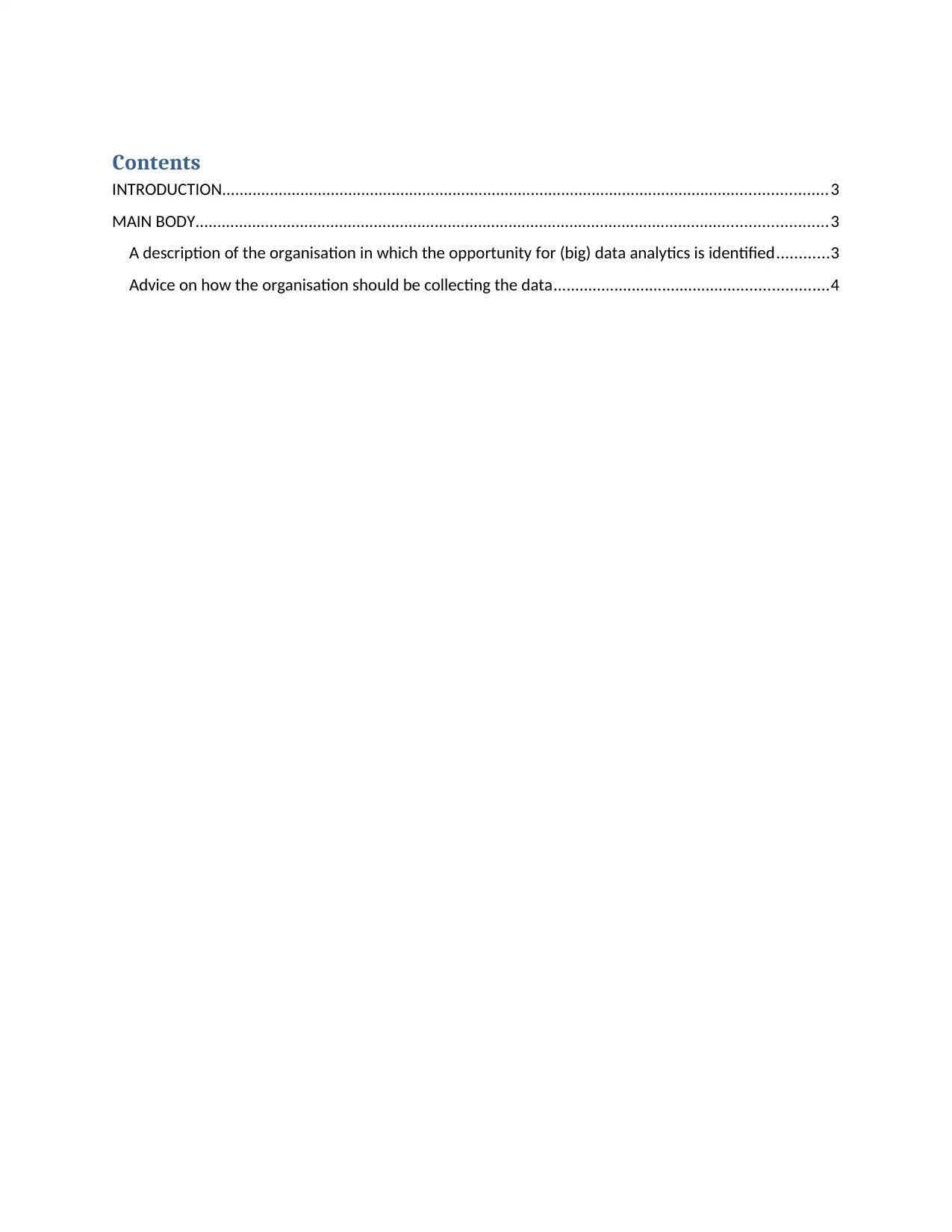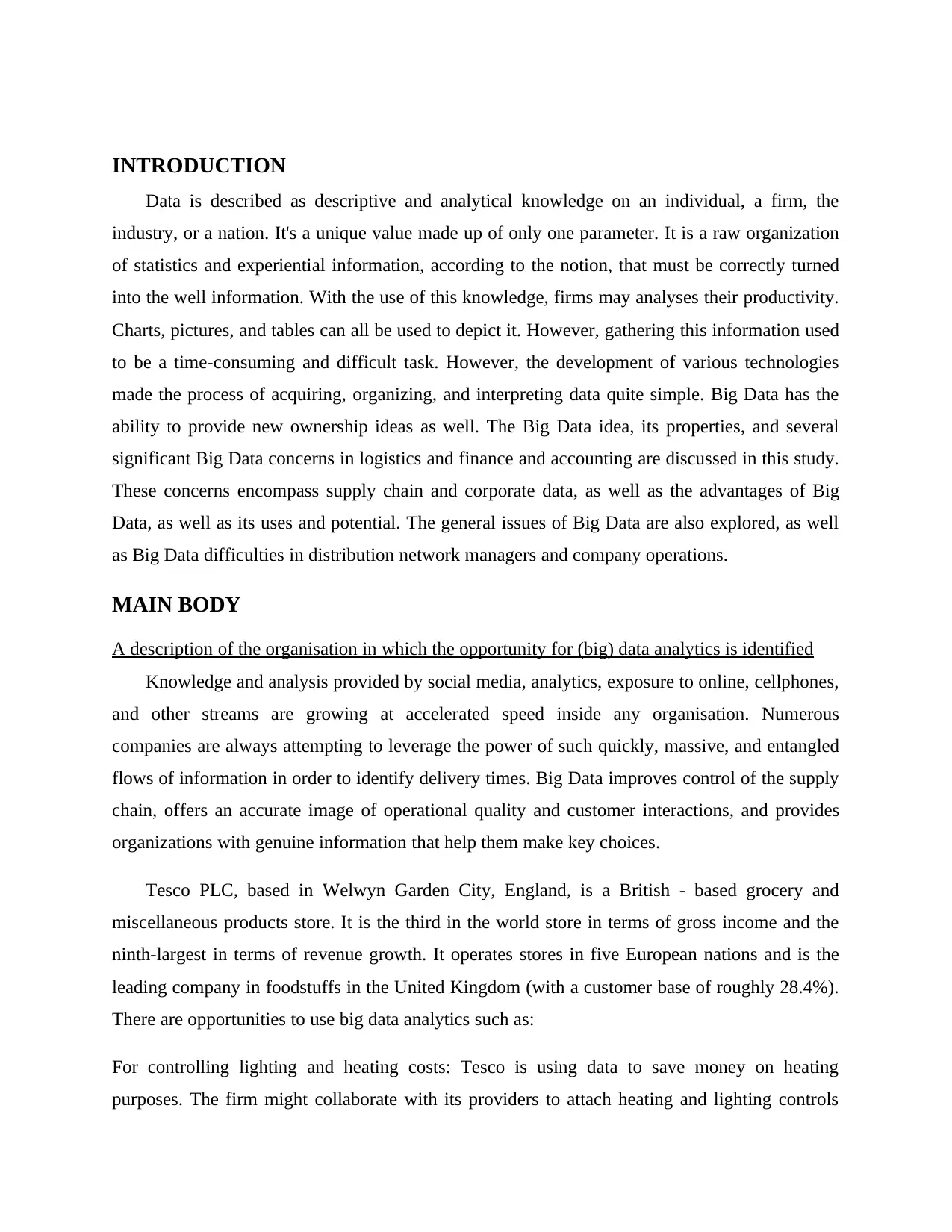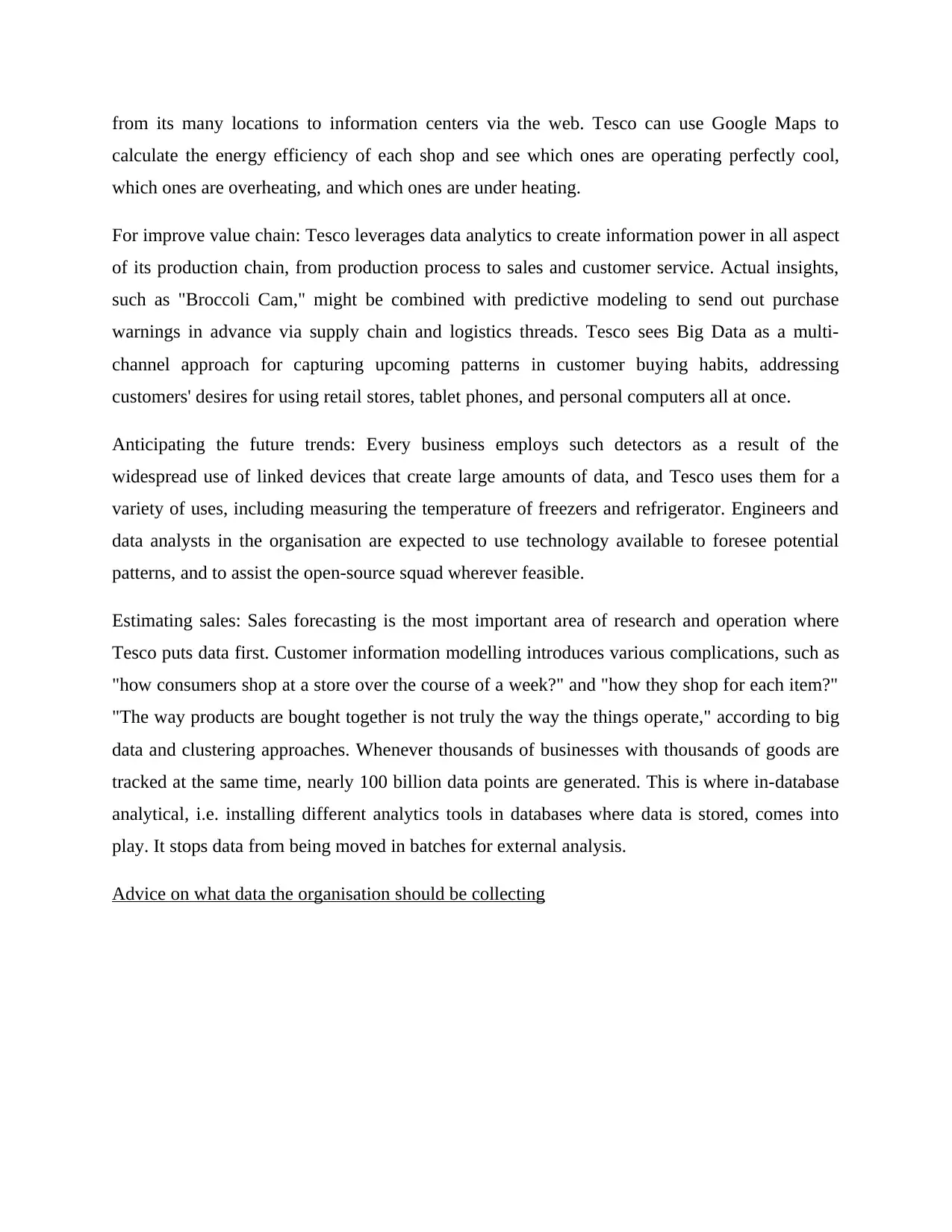Big Data Analytics: Tesco PLC's Opportunities, Collection Methods
VerifiedAdded on 2023/06/13
|6
|1147
|71
Report
AI Summary
This report delves into the potential of big data analytics within Tesco PLC, a leading grocery and merchandise retailer. It identifies opportunities such as optimizing heating and lighting costs, enhancing the value chain through insights like 'Broccoli Cam,' predicting future trends using linked devices, and improving sales forecasting. The report also offers advice on data collection methods, emphasizing the importance of selecting appropriate methods (qualitative vs. quantitative), ensuring data integrity by protecting participant privacy, and training staff to handle data effectively. The analysis highlights how Tesco can leverage data to gain a competitive edge by understanding customer behavior, streamlining operations, and anticipating market changes. Desklib provides access to this report and other solved assignments for students.

Big Data Analytics
Individual Coursework
Individual Coursework
Paraphrase This Document
Need a fresh take? Get an instant paraphrase of this document with our AI Paraphraser


Contents
INTRODUCTION...........................................................................................................................................3
MAIN BODY.................................................................................................................................................3
A description of the organisation in which the opportunity for (big) data analytics is identified............3
Advice on how the organisation should be collecting the data...............................................................4
INTRODUCTION...........................................................................................................................................3
MAIN BODY.................................................................................................................................................3
A description of the organisation in which the opportunity for (big) data analytics is identified............3
Advice on how the organisation should be collecting the data...............................................................4
⊘ This is a preview!⊘
Do you want full access?
Subscribe today to unlock all pages.

Trusted by 1+ million students worldwide

INTRODUCTION
Data is described as descriptive and analytical knowledge on an individual, a firm, the
industry, or a nation. It's a unique value made up of only one parameter. It is a raw organization
of statistics and experiential information, according to the notion, that must be correctly turned
into the well information. With the use of this knowledge, firms may analyses their productivity.
Charts, pictures, and tables can all be used to depict it. However, gathering this information used
to be a time-consuming and difficult task. However, the development of various technologies
made the process of acquiring, organizing, and interpreting data quite simple. Big Data has the
ability to provide new ownership ideas as well. The Big Data idea, its properties, and several
significant Big Data concerns in logistics and finance and accounting are discussed in this study.
These concerns encompass supply chain and corporate data, as well as the advantages of Big
Data, as well as its uses and potential. The general issues of Big Data are also explored, as well
as Big Data difficulties in distribution network managers and company operations.
MAIN BODY
A description of the organisation in which the opportunity for (big) data analytics is identified
Knowledge and analysis provided by social media, analytics, exposure to online, cellphones,
and other streams are growing at accelerated speed inside any organisation. Numerous
companies are always attempting to leverage the power of such quickly, massive, and entangled
flows of information in order to identify delivery times. Big Data improves control of the supply
chain, offers an accurate image of operational quality and customer interactions, and provides
organizations with genuine information that help them make key choices.
Tesco PLC, based in Welwyn Garden City, England, is a British - based grocery and
miscellaneous products store. It is the third in the world store in terms of gross income and the
ninth-largest in terms of revenue growth. It operates stores in five European nations and is the
leading company in foodstuffs in the United Kingdom (with a customer base of roughly 28.4%).
There are opportunities to use big data analytics such as:
For controlling lighting and heating costs: Tesco is using data to save money on heating
purposes. The firm might collaborate with its providers to attach heating and lighting controls
Data is described as descriptive and analytical knowledge on an individual, a firm, the
industry, or a nation. It's a unique value made up of only one parameter. It is a raw organization
of statistics and experiential information, according to the notion, that must be correctly turned
into the well information. With the use of this knowledge, firms may analyses their productivity.
Charts, pictures, and tables can all be used to depict it. However, gathering this information used
to be a time-consuming and difficult task. However, the development of various technologies
made the process of acquiring, organizing, and interpreting data quite simple. Big Data has the
ability to provide new ownership ideas as well. The Big Data idea, its properties, and several
significant Big Data concerns in logistics and finance and accounting are discussed in this study.
These concerns encompass supply chain and corporate data, as well as the advantages of Big
Data, as well as its uses and potential. The general issues of Big Data are also explored, as well
as Big Data difficulties in distribution network managers and company operations.
MAIN BODY
A description of the organisation in which the opportunity for (big) data analytics is identified
Knowledge and analysis provided by social media, analytics, exposure to online, cellphones,
and other streams are growing at accelerated speed inside any organisation. Numerous
companies are always attempting to leverage the power of such quickly, massive, and entangled
flows of information in order to identify delivery times. Big Data improves control of the supply
chain, offers an accurate image of operational quality and customer interactions, and provides
organizations with genuine information that help them make key choices.
Tesco PLC, based in Welwyn Garden City, England, is a British - based grocery and
miscellaneous products store. It is the third in the world store in terms of gross income and the
ninth-largest in terms of revenue growth. It operates stores in five European nations and is the
leading company in foodstuffs in the United Kingdom (with a customer base of roughly 28.4%).
There are opportunities to use big data analytics such as:
For controlling lighting and heating costs: Tesco is using data to save money on heating
purposes. The firm might collaborate with its providers to attach heating and lighting controls
Paraphrase This Document
Need a fresh take? Get an instant paraphrase of this document with our AI Paraphraser

from its many locations to information centers via the web. Tesco can use Google Maps to
calculate the energy efficiency of each shop and see which ones are operating perfectly cool,
which ones are overheating, and which ones are under heating.
For improve value chain: Tesco leverages data analytics to create information power in all aspect
of its production chain, from production process to sales and customer service. Actual insights,
such as "Broccoli Cam," might be combined with predictive modeling to send out purchase
warnings in advance via supply chain and logistics threads. Tesco sees Big Data as a multi-
channel approach for capturing upcoming patterns in customer buying habits, addressing
customers' desires for using retail stores, tablet phones, and personal computers all at once.
Anticipating the future trends: Every business employs such detectors as a result of the
widespread use of linked devices that create large amounts of data, and Tesco uses them for a
variety of uses, including measuring the temperature of freezers and refrigerator. Engineers and
data analysts in the organisation are expected to use technology available to foresee potential
patterns, and to assist the open-source squad wherever feasible.
Estimating sales: Sales forecasting is the most important area of research and operation where
Tesco puts data first. Customer information modelling introduces various complications, such as
"how consumers shop at a store over the course of a week?" and "how they shop for each item?"
"The way products are bought together is not truly the way the things operate," according to big
data and clustering approaches. Whenever thousands of businesses with thousands of goods are
tracked at the same time, nearly 100 billion data points are generated. This is where in-database
analytical, i.e. installing different analytics tools in databases where data is stored, comes into
play. It stops data from being moved in batches for external analysis.
Advice on what data the organisation should be collecting
calculate the energy efficiency of each shop and see which ones are operating perfectly cool,
which ones are overheating, and which ones are under heating.
For improve value chain: Tesco leverages data analytics to create information power in all aspect
of its production chain, from production process to sales and customer service. Actual insights,
such as "Broccoli Cam," might be combined with predictive modeling to send out purchase
warnings in advance via supply chain and logistics threads. Tesco sees Big Data as a multi-
channel approach for capturing upcoming patterns in customer buying habits, addressing
customers' desires for using retail stores, tablet phones, and personal computers all at once.
Anticipating the future trends: Every business employs such detectors as a result of the
widespread use of linked devices that create large amounts of data, and Tesco uses them for a
variety of uses, including measuring the temperature of freezers and refrigerator. Engineers and
data analysts in the organisation are expected to use technology available to foresee potential
patterns, and to assist the open-source squad wherever feasible.
Estimating sales: Sales forecasting is the most important area of research and operation where
Tesco puts data first. Customer information modelling introduces various complications, such as
"how consumers shop at a store over the course of a week?" and "how they shop for each item?"
"The way products are bought together is not truly the way the things operate," according to big
data and clustering approaches. Whenever thousands of businesses with thousands of goods are
tracked at the same time, nearly 100 billion data points are generated. This is where in-database
analytical, i.e. installing different analytics tools in databases where data is stored, comes into
play. It stops data from being moved in batches for external analysis.
Advice on what data the organisation should be collecting

Advice on how the organisation should be collecting the data
The practice of gathering, evaluating, and evaluating correct findings for investigation using
established approved procedures is referred to as data collecting. On the facts of the case
gathered, a researcher might assess their theory. Regardless of the subject of study, data
collecting is usually the first and most significant phase in the design process. Based upon the
information needed, different approaches of data gathering are used in various disciplines of
research.
Select appropriate collection methods: They may gather their information using a variety of
approaches. "Are you going to gather qualitative or quantitative data?" is the first inquiry that
should ask. Open-ended replies, such as those obtained from focused families and single
encounters, are known as qualitative data. Qualitative data is a collection of numbers obtained by
interviews, surveys, and inquiries.
Ensure data integrity: Data integrity refers to the safeguarding of the information you acquire.
Their company creates more reliable and timely information by maintaining data integrity. Data
integrity necessitates participants' privacy. For example, they strongly advise that members'
identities be protected by creating a great identification for every member.
Train staff: The integrity of company data is mostly determined by their employees. It is vital
that company employees understand everything they are doing, from developing the
questionnaire to performing focus group discussion to inputting, maintaining, cleaning, and
evaluating data. Everyone who deals with data, in my experience, has to be trained. Career
opportunities, seminars, workshops, studying papers on the topic, attending college courses, and
interacting with academics and examiners are all examples of education.
The practice of gathering, evaluating, and evaluating correct findings for investigation using
established approved procedures is referred to as data collecting. On the facts of the case
gathered, a researcher might assess their theory. Regardless of the subject of study, data
collecting is usually the first and most significant phase in the design process. Based upon the
information needed, different approaches of data gathering are used in various disciplines of
research.
Select appropriate collection methods: They may gather their information using a variety of
approaches. "Are you going to gather qualitative or quantitative data?" is the first inquiry that
should ask. Open-ended replies, such as those obtained from focused families and single
encounters, are known as qualitative data. Qualitative data is a collection of numbers obtained by
interviews, surveys, and inquiries.
Ensure data integrity: Data integrity refers to the safeguarding of the information you acquire.
Their company creates more reliable and timely information by maintaining data integrity. Data
integrity necessitates participants' privacy. For example, they strongly advise that members'
identities be protected by creating a great identification for every member.
Train staff: The integrity of company data is mostly determined by their employees. It is vital
that company employees understand everything they are doing, from developing the
questionnaire to performing focus group discussion to inputting, maintaining, cleaning, and
evaluating data. Everyone who deals with data, in my experience, has to be trained. Career
opportunities, seminars, workshops, studying papers on the topic, attending college courses, and
interacting with academics and examiners are all examples of education.
⊘ This is a preview!⊘
Do you want full access?
Subscribe today to unlock all pages.

Trusted by 1+ million students worldwide
1 out of 6
Related Documents
Your All-in-One AI-Powered Toolkit for Academic Success.
+13062052269
info@desklib.com
Available 24*7 on WhatsApp / Email
![[object Object]](/_next/static/media/star-bottom.7253800d.svg)
Unlock your academic potential
Copyright © 2020–2025 A2Z Services. All Rights Reserved. Developed and managed by ZUCOL.




